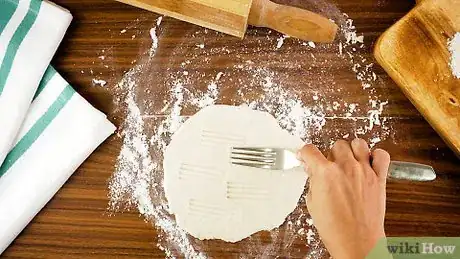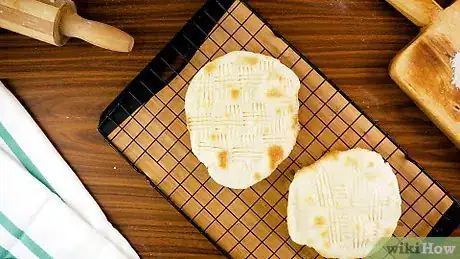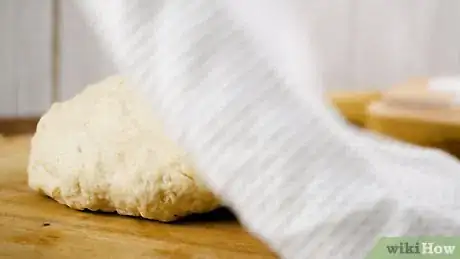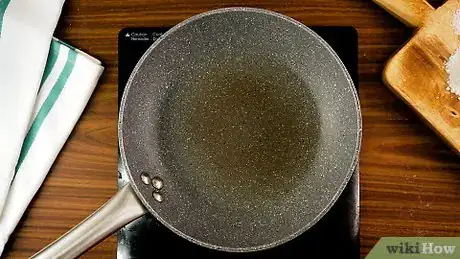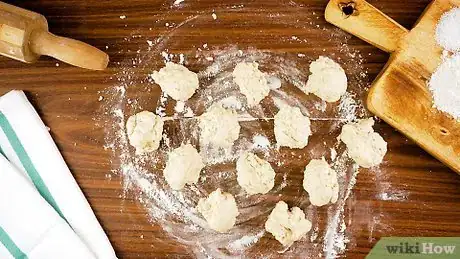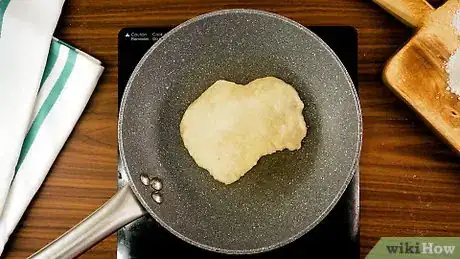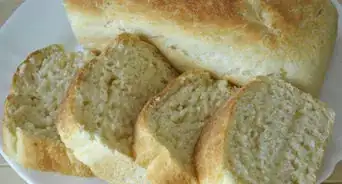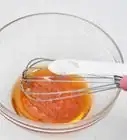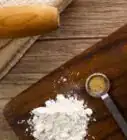This article was co-authored by wikiHow staff writer, Jessica Gibson. Jessica Gibson is a Writer and Editor who's been with wikiHow since 2014. After completing a year of art studies at the Emily Carr University in Vancouver, she graduated from Columbia College with a BA in History. Jessica also completed an MA in History from The University of Oregon in 2013.
There are 10 references cited in this article, which can be found at the bottom of the page.
The wikiHow Video Team also followed the article's instructions and verified that they work.
This article has been viewed 443,374 times.
Learn more...
Yeast, baking soda, baking powder, and egg whites are all traditional leaveners. If you don't want to bake with them because of religious reasons or time constraints, you can still whip up unleavened bread. Roll out thin matzo that crisps up when you bake it in the oven or make flexible roti flatbreads by cooking thinly-rolled discs of dough on the stove.
Ingredients
- 2 cups (240 g) of all-purpose flour, plus extra as needed
- 1/2 teaspoon (2.5 g) of kosher salt
- 1⁄3 cup (79 ml) plus 3 tablespoons (44 ml) of water
- 2 tablespoons (30 ml) plus 1 teaspoon (4.9 ml) of olive oil
Makes 4 large pieces
- 3 cups (390 g) of whole-wheat flour
- 1 teaspoon (5.5 g) of kosher salt
- 2 tablespoons (30 ml) of vegetable oil
- 1 to 1 1⁄2 cups (240 to 350 ml) of water
- Melted butter or ghee, for brushing
Makes 1 dozen roti
Steps
Baking Crisp Matzo
-
1Place an upside-down baking sheet in the oven and turn the oven to 500 °F (260 °C). You'll be cooking the matzo on the baking sheet and heating it ensures that the matzo will become crisp.[1]
- If you prefer, use a pizza stone instead of a baking sheet.
-
2Mix the flour, salt, olive oil, and water in a bowl. Put 2 cups (240 g) of all-purpose flour into a mixing bowl and add 1/2 teaspoon (2.5 g) of kosher salt along with 2 tablespoons (30 ml) plus 1 teaspoon (4.9 ml) of olive oil. Use your fingers or a spoon to stir in 1⁄3 cup (79 ml) plus 3 tablespoons (44 ml) of water.[2]
- You can use virgin or extra-virgin olive oil or substitute another oil, such as canola, coconut, or vegetable oil, if you prefer.
Advertisement -
3Knead the matzo dough for 4 to 5 minutes. Use your fingers to fold and stretch the dough in the bowl until it pulls away from the sides of the bowl. Keep folding and stretching the dough until it's soft and easy to knead.[3]
- If the dough is still too dry, mix in 1 tablespoon (15 ml) of water at a time.
-
4Divide the dough into 4 pieces and roll each as thin as possible. Portion the dough into equal pieces and set them on a floured work surface. Take a rolling pin and roll each piece out so it's as thin as you can make it. If you can, roll the matzos so thinly that you can hold them up and see light coming through them.[4]
- Roll the matzos into any shape you like so they're at least 6 inches (15 cm) in diameter. Try simple ovals or rectangles, for instance.
-
5Poke the surface of the matzos with a fork and brush them with oil if you like. Push the tines of a fork into the surface of each matzo piece to prevent them from puffing up too much as they bake. If you'd like the matzos to be golden on top, dip a pastry brush into vegetable or olive oil and brush it over the top of each matzo.[5]
Tip: If you want extra-flavorful matzos, sprinkle a little flaky sea salt over them or scatter sesame seeds on top for a little crunch.
-
6Lay 1 or 2 matzos on the hot baking sheet. You might be able to fit 2 pieces on the sheet if your sheet is large enough. If it isn't big enough, you'll have to bake 1 matzo at a time.[6]
- It's fine to place the matzos close together on the baking sheet since they won't expand as they bake. Just ensure that the pieces aren't touching.
-
7Bake the matzos for 3 to 4 minutes and flip them halfway through the baking time. Let the matzos bake on the sheet until they're crisp and brown. To help them cook evenly, use tongs to carefully flip them over halfway through the cooking time.[7]
-
8Cool the matzos on a rack and store them at room temperature for up to 1 week. Arrange the matzos in a single layer on a cooling rack. Serve the matzos once they're completely cool or put them into an airtight storage container and use them within 1 week.[8]
- The matzos will soften the longer they're stored, so eat them quickly if you like them crisp.
Making Simple Roti Flatbreads
-
1Combine whole-wheat flour, salt, and oil in a bowl. Put 3 cups (390 g) of whole-wheat flour into a large mixing bowl and add 1 teaspoon (5.5 g) of kosher salt along with 2 tablespoons (30 ml) of vegetable oil. Use your fingers or a spoon to stir until the oil is distributed and the mixture is crumbly.[9]
- If you prefer, substitute melted butter or ghee for the vegetable oil.
-
2Mix in 1 cup (240 ml) of the water to form a soft dough. Pour 1 cup (240 ml) of the water and set the rest aside since you may not need it all. Use your fingers or a spoon to stir the mixture until the flour absorbs all of the water and begins to pull away from the side of the bowl.[10]
- If the dough is too dry to stay together, slowly mix in more of the remaining 1⁄2 cup (120 ml) of water.
- Avoid pouring all of the water in at once or your dough might become too sticky to work with.
-
3Knead the roti dough for 10 minutes. Stretch and fold the dough in the bowl until it's smooth and elastic. The dough will become easier to knead as you continue to work it.[11]
- There's no proper way to knead dough, so try folding and stretching the dough until you find a method that you prefer.
- Don't sprinkle more flour over the dough or it may become too dry to roll out.
-
4Cover the dough and let it rest at room temperature for 20 to 30 minutes. Lay a damp cloth on the dough to prevent it from drying out. Leave the dough at room temperature for 20 to 30 minutes so the gluten in the dough relaxes.[12]
- You could also use an overturned bowl to cover the dough.
-
5Heat a skillet or tawa over medium heat. Set an ungreased or nonstick skillet on the stove and turn the burner to medium. If you have a tawa, an Indian skillet, use this instead.
- Let the skillet or tawa heat while you begin rolling out the roti.
-
6Divide the dough into 12 pieces and roll each piece into a ball. Pull off the dough to make 12 equal portions. Then, roll a piece in between the palms of your hands to make a smooth ball. Set the balls on your work surface and lay the damp cloth over them.[13]
- If you prefer, cut the dough into 12 equal pieces.
-
7Roll each ball into a 6 to 8 in (15 to 20 cm) circle. Press down on 1 ball to flatten it slightly. Dip it into a little whole-wheat flour and place it on a flat surface. Then, roll the ball into a thin circle.[14]
- Turn the dough circle as you roll it out to prevent it from sticking to your work surface.
-
8Place 1 circle in the skillet and cook it for 1 minute. Slowly lower 1 of the rolled pieces of dough into the hot, ungreased skillet. Let the roti cook for 1 minute so it begins to puff up in the center.[15]
Tip: To make more roti faster, set up 2 skillets so you can cook 2 roti at the same time.
-
9Flip the roti over and cook it for 1 more minute. Use tongs or a spatula to turn the roti over. Cook it until it blisters in a few spots and no longer looks doughy on either side.[16]
- Continue to cook the roti in the skillet 1 at a time.
-
10Brush the roti with melted butter or ghee. Transfer the cooked roti to a serving plate and spread some melted butter or ghee across the top. Stack the cooked roti on each other and lay a clean dry towel over them to keep them warm.
- Store the leftover roti in an airtight container at room temperature for up to 2 days.
Community Q&A
Did you know you can get answers researched by wikiHow Staff?
Unlock staff-researched answers by supporting wikiHow
-
QuestionAre tortillas unleavened bread?
 wikiHow Staff EditorThis answer was written by one of our trained team of researchers who validated it for accuracy and comprehensiveness.
wikiHow Staff EditorThis answer was written by one of our trained team of researchers who validated it for accuracy and comprehensiveness.
Staff Answer wikiHow Staff EditorStaff Answer
wikiHow Staff EditorStaff Answer -
QuestionWhat is unleavened bread made of?
 wikiHow Staff EditorThis answer was written by one of our trained team of researchers who validated it for accuracy and comprehensiveness.
wikiHow Staff EditorThis answer was written by one of our trained team of researchers who validated it for accuracy and comprehensiveness.
Staff Answer wikiHow Staff EditorStaff Answer
wikiHow Staff EditorStaff Answer -
QuestionHow did they make unleavened bread in the Bible?
 wikiHow Staff EditorThis answer was written by one of our trained team of researchers who validated it for accuracy and comprehensiveness.
wikiHow Staff EditorThis answer was written by one of our trained team of researchers who validated it for accuracy and comprehensiveness.
Staff Answer wikiHow Staff EditorStaff AnswerThe bread would have been baked in a clay oven, shaped somewhat like a beehive, with an opening at the top. A simple flatbread would have been made with stone-ground emmer wheat flour and a little bit of water. The flattened pieces of dough would then be stuck directly to the inner walls of the oven to cook. Some recipes call for the bread to be fried in oil instead.
wikiHow Staff EditorStaff AnswerThe bread would have been baked in a clay oven, shaped somewhat like a beehive, with an opening at the top. A simple flatbread would have been made with stone-ground emmer wheat flour and a little bit of water. The flattened pieces of dough would then be stuck directly to the inner walls of the oven to cook. Some recipes call for the bread to be fried in oil instead.
Things You'll Need
Crisp Matzo
- Measuring cups and spoons
- Baking sheet or pizza stone
- Mixing bowl
- Spoon
- Rolling pin
- Pastry brush
- Fork
- Tongs
- Wire rack
Simple Roti Flatbreads
- Mixing bowl
- Measuring cups and spoons
- Spoon
- Skillet or tawa
- Rolling pin
- Tongs or spatula
References
- ↑ https://youtu.be/YWQTngCvMwI?t=57
- ↑ https://www.kqed.org/bayareabites/80324/this-year-try-making-your-own-diy-matzo-for-passover
- ↑ https://www.kqed.org/bayareabites/80324/this-year-try-making-your-own-diy-matzo-for-passover
- ↑ https://youtu.be/YWQTngCvMwI?t=139
- ↑ https://youtu.be/YWQTngCvMwI?t=170
- ↑ https://www.thekitchn.com/try-this-homemade-matzo-81256
- ↑ https://www.thekitchn.com/try-this-homemade-matzo-81256
- ↑ https://www.thekitchn.com/try-this-homemade-matzo-81256
- ↑ https://www.washingtonpost.com/recipes/whole-wheat-roti/13962/
- ↑ https://youtu.be/LDt9yyOoSNY?t=71
- ↑ https://www.washingtonpost.com/recipes/whole-wheat-roti/13962/
- ↑ https://youtu.be/LDt9yyOoSNY?t=105
- ↑ https://youtu.be/LDt9yyOoSNY?t=114
- ↑ https://youtu.be/LDt9yyOoSNY?t=121
- ↑ https://www.washingtonpost.com/recipes/whole-wheat-roti/13962/
- ↑ https://www.washingtonpost.com/recipes/whole-wheat-roti/13962/
About This Article
If you want to make unleavened bread, start by combining flour and salt in a mixing bowl. Then, beat eggs and oil together in a separate bowl, and stir the mixture into the dry ingredients. Next, add milk and beat the mixture for 2-3 minutes or until it's smooth. To cook, pour the batter into 3 8-inch baking tins. Finish by baking the bread at 450 degrees F for 20 minutes. To learn more about the biblical history of unleavened bread, read on!

